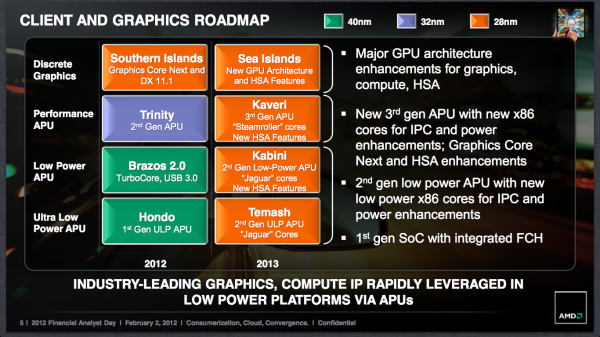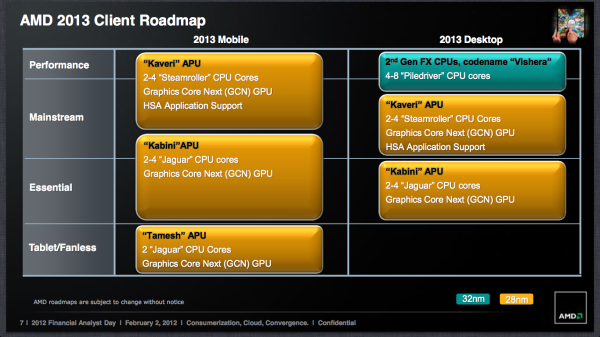Understanding AMD's Roadmap & New Direction
by Anand Lal Shimpi on February 2, 2012 6:16 PM EST- Posted in
- CPUs
- AMD
- Trade Shows
- AMD FAD 2012
We've been providing live coverage of AMD's 2012 Financial Analyst Day from Santa Clara today, but if you want a summary of the company's strategy under new CEO Rory Read you've come to the right place. Below you'll find links to everything we've published from AMD's FAD 2012:
AMD's Rory Read Outlines AMD's Future Strategy
AMD Outlines HSA Roadmap: Unified Memory for CPU/GPU in 2013, HSA GPUs in 2014
AMD is Open to Integrating 3rd Party IP in Future SoCs
AMD's Financial Analyst Day 2012 - Mark Papermaster, SVP & CTO Presentation
AMD: Flexible Around ISA
AMD Nods at Shorter Design Cycles, More Synthesized Designs
What AMD Views as Important: Tablets, Servers, Notebooks & GPUs
AMD & Compal Show Off 18mm Trinity Notebook
AMD's 2012 - 2013 Client CPU/GPU/APU Roadmap Revealed
AMD's 2012 - 2013 Server Roadmap: Abu Dhabi, Seoul & Delhi CPUs
AMD is Ambidextrous, Not Married to Any One Architecture, ARM in the Datacenter?
AMD's Tablet Architectures: Hondo at 4.5W, Future Sub-2W SoC
The name of the game for AMD in 2012 is execution. Far too often at previous AMD events we'd see a roadmap with no indication of whether or not AMD would actually stick to it. Plans were always aggressive and made sense, but execution rarely mirrored what was promised on paper. AMD in turn ended up delivering CPUs sometimes years after they were promised, which obviously didn't help grow the company.
Over the past few months Rory and his new management team at AMD have been restructuring the company to improve execution. As a much smaller company than Intel, AMD had an almost impossible task competing in the x86 space, but AMD should have also been far more agile than it was given its size. AMD's restructuring is supposed to fix these agility and execution problems. The proof will be in how well AMD is able to introduce products over the next 24 months.
As far as the roadmap goes, AMD already laid out what it hopes to accomplish by 2013. The best way to summarize AMD's next two years is: APUs and servers. On the APU side, we'll get updates to all of the current lines this year (Trinity & Brazos 2.0), but we'll also get a new 4.5W APU (Hondo) aimed at the Windows 8 tablet market. Now 4.5W is a bit high for a tablet but AMD has plans to bring even lower power architectures to market in the future. Next year we'll also see the first single-chip solutions from AMD: Kabini and Temash will integrate the I/O controller (SATA, USB ports, etc...) on-die. Intel is doing something similar with Haswell.
The big transition will happen next year, as AMD moves its entire APU stack from 32nm SOI to a bulk 28nm process at Global Foundries. This is an important move as it signifies the use of more easily synthesized designs, which enables AMD to bring out APUs in a quicker fashion and with lower design costs. Effectively everything follows the path laid by Brazos/Bobcat at this point. Note that AMD will be shipping 28nm APUs while Intel is well transitioned to 22nm, a gap that AMD has no intentions on narrowing. The process technology gap has almost always existed between AMD and Intel, but now AMD is taking a firm stance in saying that it has no intentions to blindly pursue the closing of that gap.
What once was a 3+ year design cycle for AMD CPUs and APUs now shrinks to less than 24 months (maybe even as short as 18 months) as a result of this migration to more easily synthesized designs. If this sounds a lot to you like the old GPU design cadence don't be surprised. AMD's APUs are, after all, largely made of GPU transistors that have always strayed from custom logic where possible. The big change is simply doing more non-custom x86 design.
Obviously AMD's ability to execute on this roadmap will depend heavily on Global Foundries delivering good yields at 28nm, however AMD does seem fairly confident at this point. That being said, 2013 is a very broad timeframe. Executing on the above roadmap sooner rather than later in 2013 will be the difference between a competitive AMD and one that's quickly written off.
I don't believe a move towards easily synthesized architectures is necessarily a bad thing. As long as AMD can deliver good performance at competitive prices the process technology really doesn't matter as much. Typically process technology was used as an enabler of good performance but as a newly fabless semiconductor, that strategy doesn't necessarily apply to AMD - at least not across all market segments. In other words, what works for Intel may not work for AMD.












84 Comments
View All Comments
spidey81 - Thursday, February 2, 2012 - link
With AMD's focus going the direction of mobile/AIO or server parts will the consumer market ever see anything directed at the desktop enthusiast marker? I guess I'm still hopeful to see a trickle down from the server marker or desktop innovation trickling down to the mobile sector as has been in the past. Maybe it's just time to jump ship to intel for my next gaming/oc rig.arjuna1 - Thursday, February 2, 2012 - link
You ninja'd my post, but, exactly the same feeling, but you know what?? if they dare to give me the middle I will give them the middle finger, no problem in making my next build intel/nvidiaspidey81 - Thursday, February 2, 2012 - link
I just upgraded from a PII X3 720 to an FX8120. It's frustrating to know that even with it clocked at 4.5Ghz I'm still not going to get the performance I would have with a 2500K. I've never built with anything other than AMD and really don't plan on changing that. However, It's getting increasingly difficult to support them.just4U - Thursday, February 2, 2012 - link
Hey Spidey.. your not missing to to much. I've built several i5/i7 setups and use one everyday. But I've also picked up an FX6100 and it's pretty good to. I don't mind switching back and forth and while there may be a slow down in some games .. some apps.. I don't notice it unless I am actually looking at the numbers. They all seem fast overall.Sabresiberian - Thursday, February 2, 2012 - link
My experience is different. I have built 2 computers, one on the i7 920 and one on the Phenom II 955. The difference is clear and significant playing World of Warcraft, and any other MMORPG.My experience is mirrored by Anandtech and Tomshardware benchmarks.
Now, if you aren't a person that actually uses all the performance he can get, the Phenom II is fine, but even having been an AMD fan for years, I won't go back and cut my nose off to spite my face, as they say.
AMD has chosen a different path than I would like for them to have, but I'm not going to fault them for it. I'm disappointed as an enthusiast builder, but I certainly recognize there is a far wider market than CPUs for people like me. However, it also means they no longer are interested in supplying what I want, so we must part ways.
;)
Spoelie - Friday, February 3, 2012 - link
Have been an AMD/ATI loyalist for a long time, and have only built AMD/ATI setups *for my personal use*. But I always only upgraded to a product that was either very competitive (Tbird, A64, X2, PhII early on) or dirt cheap and very overclockable (Tbred, Barton for example) - holding out the times AMD wasn't very competitive (kept my X2 pretty long, skipped PhI).The thing is that my 3 year old DDR2 Deneb@3.3ghz has never felt inadequate at all, helped by an SSD and yearly GPU upgrades.
When the time comes however, I'll have no qualms switching to Intel's latest and greatest, in the same spirit as Sabresiberian
wumpus - Wednesday, June 27, 2012 - link
>The difference is clear and significant playing World of Warcraft, and any other MMORPG.WoW was released in something like 2007. I very much doubt a modern CPU would notice the difference (I used to play Dungeons and Dragons online (2008) with a 2GHz Sempy, and it ran just fine). Methinks you have different GPUs and that might just make the difference (WoW used to be famous for not stressing the GPU, I doubt they have changed it).
Still, as someone who has always liked AMD more than Intel, I suspect I will wind up buying more Intel processors in the future (the fact that every single Intel processor I've bought has been deliberately crippled annoys the bejesus out of me).
Face it, the desktop is "dying" (read becoming a mature tech that doesn't obsolete itself every Thursday). Don't expect every high tech company to want to swoop down and grab a piece of the pie anymore. Intel will have a hard enough time with every "tock" competing with the previous "tick".
GotThumbs - Friday, February 3, 2012 - link
I think one of the key factors your leaving out...Is what is the cost/price difference. I've built all AMD systems since my first Pentium II build, and been quite happy with the system and the performance I've gotten, while still having some cash left in my pockets. I'm even looking at down-sizing my system to an APU on an ITX board with an SSD. Today's CPU's meet probably 95% of the markets needs. It's only a select few who need hard-core performance on an hourly basis and can justify spending huge amounts of money to have a high-powered system. Higher CPU speeds is not the only focus in today's market. Battery life and user experience is what matters. If you can get the same experience with a lower speed processor...then whay pay more....bragging rights only takes you so far.I think AMD has matured and is no longer concerned with competing with Intel on having the biggest and baddest CPU's. Most general consumers barely use 1/3 the capacity of their systems.
bill4 - Thursday, February 2, 2012 - link
Its funny how people hate AMD so much they automatically push this "AMD is getting out of the high end!" agenda in post along the internet. It's not commentary, it's your hope.Nvidia is the only one getting out of the high end since they dont even have a competitor to Tahiti.
Amd Bulldozer was definitely a play at the high end, it's a huge ambitious chip, it just sucks.
Get your head out of your ass Nvidia fanboys, AMD is not going anywhere no matter how hard you wish it/
arjuna1 - Thursday, February 2, 2012 - link
Hey bill, I've been building AMD/ATI since the K6/9800, why don't you just stfu, learn to read before opening your mouth.